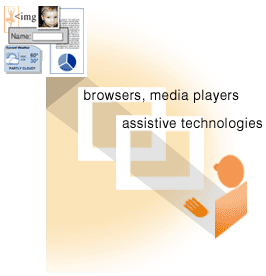User Agent Accessibility Guidelines (UAAG) Overview
For Browsers, Media Players, and other "User Agents"
Page Contents
Quick links: UAAG 1.0, UAAG 2.0 Current Draft
User Agent Accessibility Guidelines (UAAG)
The User Agent Accessibility Guidelines (UAAG) documents explain how to make user agents accessible to people with disabilities, particularly to increase accessibility to Web content. User agents include Web browsers, media players, and assistive technologies, which are software that some people with disabilities use in interacting with computers.
UAAG is part of a series of accessibility guidelines, including the Web Content Accessibility Guidelines (WCAG WG) and the Authoring Tool Accessibility Guidelines (ATAG). Essential Components of Web Accessibility explains the relationship between the different guidelines.
Who UAAG is for
UAAG is primarily for developers of Web browsers, media players, assistive technologies, and other user agents.
UAAG and supporting resources are also intended to meet the needs of many different audiences, including policy makers, managers, and others. For example:
- People who want to choose user agents that are more accessible can use UAAG to evaluate user agents
- People who want to encourage their existing user agent developer to improve accessibility in future versions can refer the user agent vendor to UAAG
What is in UAAG 1.0
UAAG 1.0 contains a comprehensive set of checkpoints that cover:
- Access to all content, including content tied to events triggered by the mouse or keyboard
- User control over how content is rendered
- User control over the user interface, with documentation of accessibility features
- Standard programming interfaces, to enable interaction with assistive technologies
Technical document format
UAAG 1.0, the techniques documents, and the checklist follow the W3C format for technical specifications which includes several sections at the beginning: links to differnt versions, editors, copyright, abstract, and status with the link to errata and the email address for comments. Most WAI specifications have a link at the top to the Table of Contents.
UAAG Versions: 1.0 and 2.0
User Agent Accessibility Guidelines 1.0 was approved in December 2002 and is the stable and referenceable version.
UAAG 2.0 is being developed to help make the next and future generations of Web browsers functionally accessible, provide access to alternative information based on the users technology and platform, and align with WCAG 2.0 and ATAG 2.0. WAI anticipates UAAG 2.0 may be completed in 2010. Because of the nature of the W3C development process, WAI cannot be certain when the final version of UAAG 2.0 will be available. UAAG 1.0 will remain the latest approved version until version 2.0 is complete.
Who develops UAAG
UAAG technical documents are developed by the User Agent Accessibility Guidelines Working Group (UAWG), which is part of the World Wide Web Consortium (W3C) Web Accessibility Initiative (WAI). For more information about the working group, see the UAWG page.
How WAI Develops Accessibility Guidelines through the W3C Process: Milestones and Opportunities to Contribute describes formal periods for public review. Opportunities for review and comment of WAI documents are announced on the WAI home page and WAI Interest Group mailing list. An email address for sending comments is included in the "Status of this Document" section.
Opportunities for contributing to UAAG and other WAI work are introduced in Participating in WAI.
 Translations
Translations